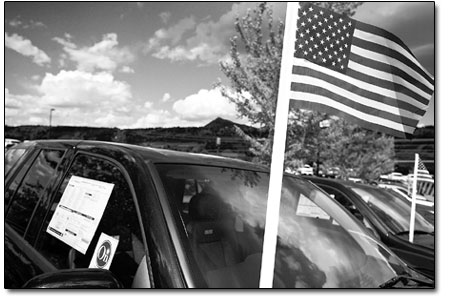| ||
| Taking a pass at the pump Durango and La Plata County adapt to new energy picture SideStory: A dozen ways to drive smart
by Jeff Mannix If you follow the Kübler-Ross Five Stages of Grief – denial, anger, bargaining, depression, acceptance –the world, and the greater Durango area, are somewhere between depression and acceptance over the current state of its energy crisis. Currently, supply is exceeding demand as users of motor fuel are in conservation mode. That, in turn, has driven the price of crude oil down along with the retail price of gasoline and diesel. A similar thing happened with the Arab Oil Embargo in 1973, when OPEC countries decreased their shipment of oil to Western countries and the resultant conservation effort forced an almost immediate glut of oil in the marketplace. Now, however, the Western world is not being punished by Arab oil producers as it was in 1973. Developing countries are using more fossil fuels, the U.S. – up until the past six months or so – has had an extravagant fuel habit. By all credible estimates, the world has reached peak oil production and may never return to the good old days of extremely cheap energy. So what is Durango doing and what can we do to reduce the dependence on fossil fuel, save money to spend on the rising cost of everything else, and reduce the emissions of smothering carbon in our deteriorating atmosphere? Public transportation is a logical choice to replace thousands of vehicles on the roads in cities, and many big metropolitan areas have very sophisticated and well-used public transit systems. The Durango community, however, is spread out over 800 miles of roadway and includes only a small city center, making complete conversion to public transit impossible. Nonetheless, Ann Capela, manager of Durango Transit, says that Durango is rediscovering public transit. “Durango Transit is experiencing the highest level of increased ridership in its history so far in 2008,” she said. “From January to July we’ve seen a 32 percent increase in ridership. There is now an average of 207,000 rider trips on our buses and trollies.” With some of the lowest fares in the state, Durango Transit runs nine buses on half-hour schedules on various loops through town and out to Mercy Medical Center. In addition, ground will be broken on Aug. 18 on a new transit center in the 700 block of Camino del Rio. The center will consolidate all public and private mass transportation in a high-profile location with ample parking and easy access to downtown. Still, with 70 percent of La Plata County’s population living outside the City of Durango, public transportation is not addressing the needs of the majority of the county’s residents. “We’re hoping to expand out into the county, and we once had a contract with La Plata County, but it wasn’t renewed,” Capela said. Meanwhile, a high level of distrust has further destabilized the current energy picture. Jim Morehart, owner of Morehart Chevrolet and Subaru, noted that the auto industry has seen better days. “Everybody is distrustful of the whole system, from fuel production to manufacturing of vehicles,” he said. “So they’re waiting to understand how the price of oil can fluctuate so much from one day to the next, and they’re not replacing their vehicles.” With 80 percent of new vehicle purchases accompanied by a trade-in, car dealers are facing a new bottleneck. “In this economic and energy environment, we have no idea what a used vehicle is worth,” Morehart said. “So we can’t take a chance on the trade-in. Even the auctions, who really set the used prices for everybody, aren’t selling more than 20 percent of their offerings. We’re flying blind.” The Federal Highway Administration reports that during the first five months of this year, Americans drove 30 billion fewer miles than they did during the same period last year. Kelly Brennan of Brennan Oil, bulk fuel dealer and multi-unit retailer of Exxon gasoline in Durango, has seen this change first hand. “At this time last year we had sold close to 500,000 gallons of fuel,” he reported. “ This year we’re 250,000 gallons down. Our prices are fluctuating daily, up and down for no recognizable reason. We’re not making any profit at all, even on the loads that are down. If it weren’t for the convenience items in our gas stations, we wouldn’t be in business.” With the demand for vehicles drastically reduced and fuel consumption plummeting, prices of gasoline, cars and trucks are also steadily going down. Yet, the price of fuel, no matter where it stabilizes, will not bring the nation back to the halcyon days of predictable and sensible prices of anything requiring transportation or energy consumption Taking the energy crisis seriously, La Plata County has recently kicked off a “Drive Smart’’ program for its fleet vehicles to add to their ongoing energy management efforts. Jana Lee, chairwoman of the county’s Energy Management & Resource Conservation Committee, noted that the county is taking many steps to lighten its footprint. “We’re changing ways we manage facilities, using more biodiesel in our trucks, doing a lot more teleconferencing, and holding seminars for county employees to learn how to conserve electricity, office supplies, and their own resource consumption,” she said. “We now even have a full-time sustainability coordinator.” These steps and others being taken throughout the community indicate that Durango and La Plata County are well onto a path of a new frontier. “It’s amazing how much you can alter habits to conserve,” Lee concluded. •
|


